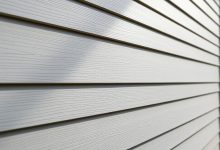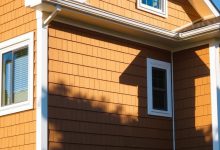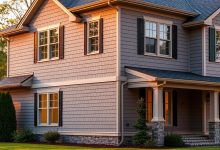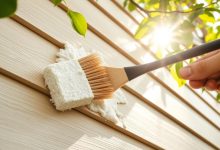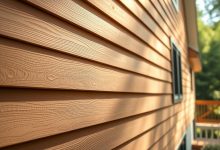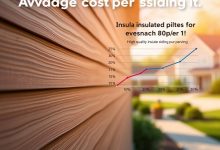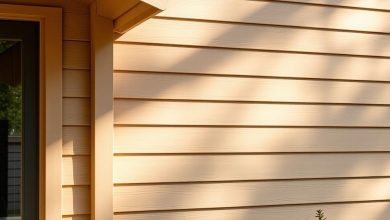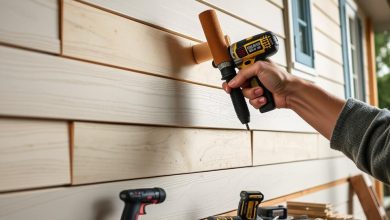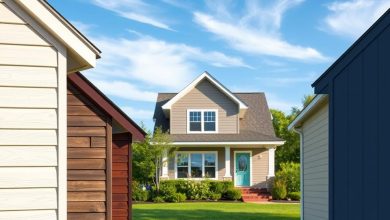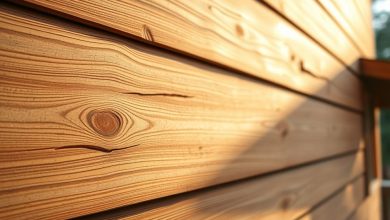Insulated Siding: Long-Lasting Exterior Protection
Homeowners in the United States are always searching for ways to better their homes. They look for ways to protect their homes’ exteriors and increase their value. Insulated siding is a great solution, acting as a strong shield against the elements.
Exterior protection is key to keeping a home strong and energy-efficient. Insulated siding not only guards against bad weather but also cuts down on energy bills.
As a home improvement choice, insulated siding brings many benefits. It boosts energy efficiency and raises a home’s value.
Key Takeaways
- Insulated siding provides robust exterior protection for homes.
- It helps reduce energy costs and improve energy efficiency.
- Insulated siding is a valuable home improvement solution.
- It increases property value and improves a home’s overall integrity.
- Exterior protection is vital for keeping a home in good condition.
What Is Insulated Siding?
Insulated siding is a big step forward in building tech. It keeps your home warmer and cooler, saving you money on energy. It also protects your home from the weather and makes it look better.
Definition and Basic Components
Insulated siding has several layers. In the middle, there’s foam plastic for insulation. This helps keep your home’s temperature steady. On the outside, you can choose from vinyl, fiber cement, or wood for durability.
How It Differs from Traditional Siding
Insulated siding is different from traditional siding in many ways. It’s better at keeping your home warm or cool, blocks out noise, and is stronger. Traditional siding just protects the outside. Insulated siding does all that and more, making your home more comfortable and saving you money.
The Evolution of Home Exterior Protection
The history of siding materials is filled with innovation and adapting to the environment. Homeowners and builders have always looked for materials that protect homes and look good. They want to keep their homes safe from the weather and make them look better.
Historical Development of Siding Materials
Long ago, siding choices were based on what was available, how long it lasted, and its cost. Wood, vinyl, and metal were the top picks. Each had its own good points and bad points, like how they looked and how well they stood up to weather and pests.
The need for better performance and being green pushed these materials to evolve.
The Introduction of Insulated Siding Technology
Insulated siding technology was a big step forward. It makes homes more energy-efficient and durable. Homeowners save money on energy, stay comfortable, and get better protection from the weather.
This technology is a big leap in home improvement. It solves many problems that old siding materials had.
Key Benefits of Insulated Siding
Insulated siding does more than just protect your home. It makes your living space more comfortable, quieter, and durable. This is thanks to the insulation built into the siding.
Enhanced Energy Efficiency
One big plus of insulated siding is its energy efficiency boost. It stops heat from moving between inside and outside. This keeps your home’s temperature steady, saving you money on heating and cooling.
Improved Noise Reduction
Insulated siding also cuts down on noise. Its insulation layer blocks outside sounds, making your home quieter. This is great for homes near busy streets or noisy areas.
Increased Structural Integrity
Insulated siding also makes your home stronger. It adds a protective layer against wind, rain, and cold. This means less damage and lower upkeep costs over time.
Types of Long-Lasting Insulated Siding
The market has many types of long-lasting insulated siding. They meet different needs and tastes. Homeowners can pick from various materials, each with its own benefits and possible downsides.
Vinyl Insulated Siding
Vinyl insulated siding is loved for its toughness and easy care. It stands up well to pests and weather, making it a smart choice for many. Vinyl siding also comes in many colors and styles, fitting various home designs.
Fiber Cement Insulated Options
Fiber cement insulated siding is durable and fights off fire, pests, and harsh weather. It’s made from cement, sand, and cellulose fibers, giving a solid exterior. Fiber cement siding looks like wood but doesn’t need the upkeep wood does.
Engineered Wood with Insulation
Engineered wood siding with insulation offers wood’s natural look but is more durable and energy-efficient. It’s made by stacking wood fibers in different ways, reducing warping and shrinking. This siding is a green and attractive choice for those wanting wood’s look.
| Siding Type | Durability | Maintenance | Aesthetic Versatility |
|---|---|---|---|
| Vinyl Insulated Siding | High | Low | High |
| Fiber Cement Insulated Siding | High | Medium | Medium |
| Engineered Wood with Insulation | Medium | Medium | High |
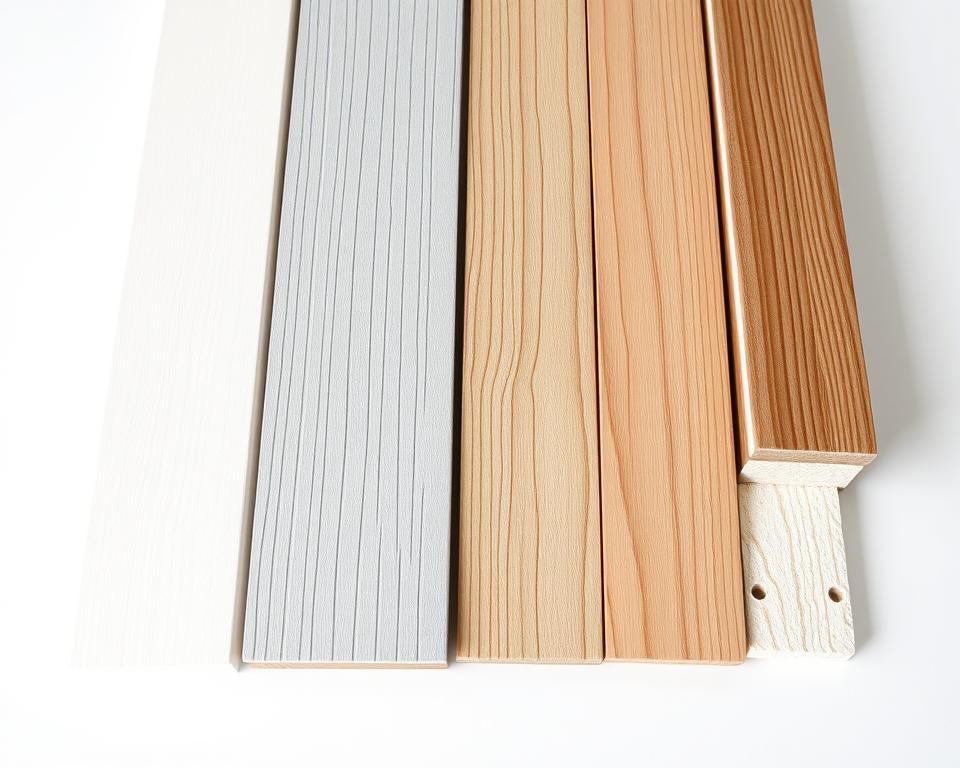
Materials and Construction
Insulated siding is made from a mix of materials. These materials make the siding strong and energy-saving. This makes insulated siding a great choice for those wanting to protect their home’s exterior.
Insulation Core Materials
The heart of insulated siding is foam insulation. This foam is usually expanded polystyrene (EPS) or extruded polystyrene (XPS). These foams are picked for their ability to keep heat in or out, which is key for energy efficiency.
Exterior Facing Options
The outside of insulated siding faces the weather. It’s made from vinyl, fiber cement, or engineered wood. Each material offers its own perks, like lasting long, needing little care, and looking good.
An architect once said, “The exterior cladding is not just about looks; it’s also about keeping the building safe.”
Knowing about insulated siding’s materials helps homeowners choose the best for their needs.
The Science Behind Long-Lasting Insulated Siding
Homeowners are looking for ways to cut down on energy use. Insulated siding is key in this effort. It’s not just a simple exterior fix; it’s a complex system. It boosts a home’s energy efficiency, comfort, and durability.
R-Value Explained
The R-value shows how well a material stops heat flow. For insulated siding, a higher R-value means better insulation. This is important because it helps keep your home warm in winter and cool in summer.
The R-value depends on the insulation material and its thickness. For example, foam insulation can offer a higher R-value than traditional siding.
| Insulation Material | R-Value per Inch | Typical Thickness |
|---|---|---|
| Fiberglass | 3.5-4.0 | 3.5 inches |
| Foam Insulation | 6.0-7.0 | 2.0 inches |
| Reflective Insulation | varies | 1.0 inch |
Thermal Bridging Prevention
Thermal bridging happens when heat escapes through the siding, often through framing. Insulated siding stops this by covering the home with insulation.
This prevents heat loss or gain, which saves energy. It’s vital in areas with extreme weather, as it cuts down on energy bills.
Weather Resistance and Performance
Insulated siding is made to handle different weather, making it a good choice for homes.
Its performance is key to keeping a home’s exterior strong. It fights off harsh weather, keeping the home safe and sound.
Performance in Extreme Heat and Cold
Insulated siding does well in very hot or cold weather. It lessens the chance of damage from temperature changes.
In hot weather, it keeps the outside cool. In cold, it keeps the temperature steady, stopping damage from freezing.
- Reduces thermal stress
- Prevents damage from extreme temperatures
- Maintains a stable exterior temperature
Moisture and Humidity Protection
Insulated siding fights off moisture and humidity, stopping water damage.
It’s made to resist moisture, keeping the siding strong even in humid air.
Key benefits include:
- Prevents water damage
- Resists mold and mildew
- Maintains its integrity in humid conditions
Impact and Storm Resistance
Insulated siding is built to handle impacts and harsh weather, like storms.
Installation Process and Considerations
Understanding the details of insulated siding installation is key for homeowners wanting to upgrade their exterior. A good installation boosts the siding’s performance and life span.
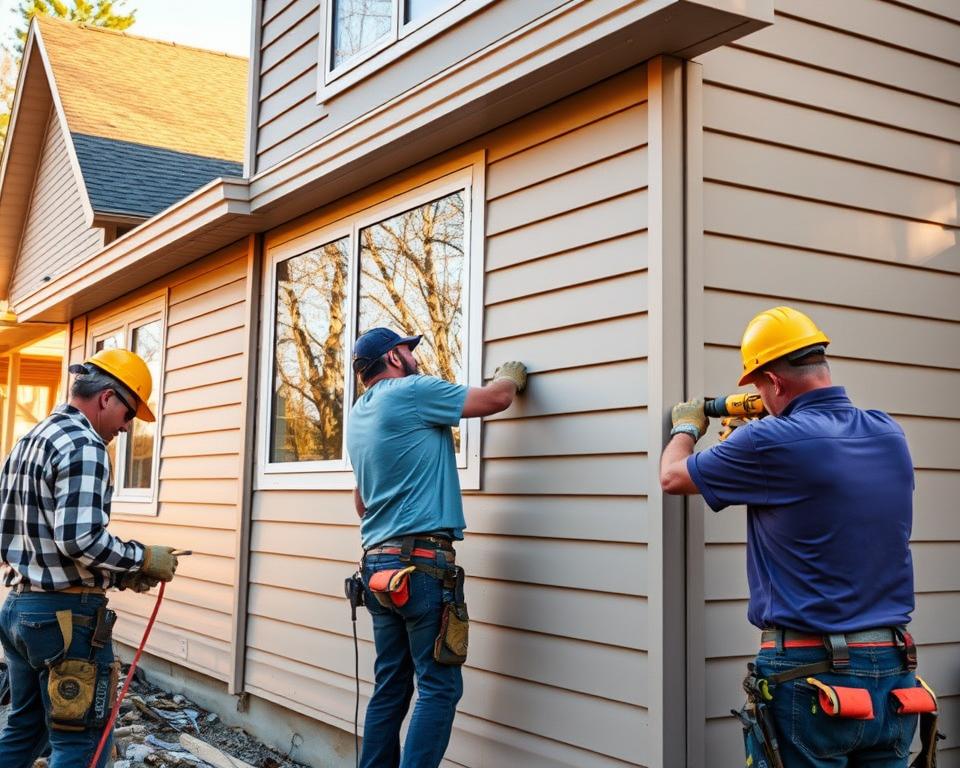
Professional vs. DIY Installation
Homeowners often wonder if to hire pros or do it themselves for siding installation. DIY can save money but needs a lot of skill and tools. Professional installation, though, guarantees a job well done, with many contractors backing their work with warranties.
As
“A successful siding installation is not just about the material; it’s about the execution.”
This shows why choosing between DIY and hiring pros is so important.
Preparation Requirements
Before starting the siding installation, site preparation is essential. This means removing old siding, checking and fixing damaged sheathing, and making sure walls are even and strong. Good preparation is vital for a successful job.
- Remove old siding and dispose of it properly
- Inspect the sheathing for any damage or rot
- Ensure walls are level and secure
Common Installation Challenges
Siding installation can face several hurdles, like uneven walls and managing insulation. Knowing these issues helps homeowners and installers avoid them.
By grasping the installation process and its challenges, homeowners can make better choices. This improves their home’s exterior and energy use.
Maintenance Requirements for Long-Lasting Insulated Siding
To keep insulated siding in top shape, regular care is key. Keeping your home’s exterior looking good also helps it work better. This includes saving energy and protecting your home’s structure.
Cleaning and Upkeep
Cleaning your siding often is a must. Dirt, debris, and mildew can harm it over time. Use a mild detergent and water solution to clean it. Stay away from high-pressure washes that could damage the siding.
For vinyl siding, a soft-bristled brush helps with tough stains. Always check for damage like cracks, dents, or fading.
Repair Procedures
Fixing damage quickly is important to avoid bigger problems. For small issues, DIY repair kits can work. But, bigger problems might need a pro to fix right and safely.
Also, fix any problems that caused the damage. This could be water getting in or structural issues.
Expected Lifespan
The life of insulated siding depends on the material and how well it’s installed. Vinyl insulated siding usually lasts 20 to 40 years. Fiber cement siding can last even longer, often over 30 years, with the right care.
| Siding Material | Average Lifespan | Maintenance Frequency |
|---|---|---|
| Vinyl Insulated Siding | 20-40 years | Annual |
| Fiber Cement Siding | 30+ years | Annual |
| Engineered Wood Siding | 20-30 years | Semi-Annual |
Cost Analysis and Return on Investment
Understanding the cost and return on investment of insulated siding is key for homeowners. It’s important to look at both the upfront cost and the long-term savings. This helps in making a smart choice.
Initial Investment Considerations
Insulated siding often costs more than traditional siding at first. This includes the price of materials and the cost of installation. Factors that influence the initial investment include the siding type, house size, and installation complexity. For example, vinyl insulated siding might cost differently than fiber cement or engineered wood.
Long-Term Savings and ROI
Even though insulated siding costs more upfront, it saves money in the long run. It helps lower energy bills by insulating better. This leads to a good return on investment (ROI) for homeowners.
Studies show insulated siding can offer a big ROI over time. This makes it a smart choice for many homeowners.
Selecting Quality Contractors and Brands
Choosing the right professionals and products is key for insulated siding. A well-installed insulated siding improves your home’s energy use and value.
What to Look for in Installation Professionals
When looking for siding contractors, check their portfolio and reviews. Make sure they are licensed and insured. This ensures you get reliable and skilled work.
Ask contractors about their experience with insulated siding. Find out their installation process and if they offer a work warranty.
Top Manufacturers and Warranty Considerations
The top manufacturers include James Hardie, CertainTeard, and LP SmartSide. Look at their product quality, warranty, and customer support when choosing.
Warranty considerations are important. Choose brands with good warranties that cover both products and labor. A solid warranty gives you peace of mind and protects your investment.
Conclusion
Long-lasting insulated siding is a great choice for any home. It offers many benefits that improve its performance and look. It makes homes more energy-efficient, quieter, and stronger.
Looking to improve your home? Insulated siding is a smart pick. It saves energy, makes your home last longer, and increases its value. You can choose from vinyl, fiber cement, or engineered wood, depending on your needs and budget.
Choosing insulated siding means a safer, more comfy, and energy-saving home. It’s a wise investment. Make sure to pick quality contractors and brands for the best results.
